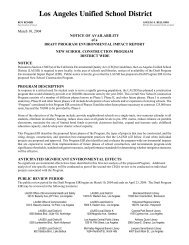Site-Specific Health and Safety Plan (HASP) - Laschools.org
Site-Specific Health and Safety Plan (HASP) - Laschools.org
Site-Specific Health and Safety Plan (HASP) - Laschools.org
You also want an ePaper? Increase the reach of your titles
YUMPU automatically turns print PDFs into web optimized ePapers that Google loves.
SECTION 2<br />
DATA QUALITY OBJECTIVES<br />
The objectives of collecting <strong>and</strong> analyzing environmental samples are to determine the<br />
distribution of chemicals of potential concern (COPCs) at the site. This QAPP has been<br />
developed for use in conjunction with sampling activities to be undertaken at the site, <strong>and</strong><br />
describes the QA/QC procedures <strong>and</strong> protocols that will be used during sample analysis.<br />
The QAPP will serve as a controlling mechanism during the investigation/remedial<br />
action to ensure that a sufficient quantity of data is collected <strong>and</strong> that all data collected<br />
are valid, reliable, <strong>and</strong> defensible. (Note: the evaluation of historical data for usability<br />
will be addressed separately.)<br />
An effective QA program addresses DQOs for both field sampling <strong>and</strong> laboratory<br />
methods. The field QA efforts will focus on ensuring that samples are representative of<br />
the conditions in the various environmental media at the time of sampling. Fixed-based<br />
subcontract laboratory QA efforts will be aimed primarily at ensuring that analytical<br />
procedures provide sufficient accuracy <strong>and</strong> precision to reliably quantify contaminant<br />
levels in environmental samples. The subcontract laboratory will also ensure that<br />
analyzed portions are representative of each sample.<br />
DQOs are developed in general accordance with the seven-step DQO process presented<br />
in USEPA (1994b) guidance for each field effort <strong>and</strong> included in the work plan for that<br />
effort.<br />
2.1 ANALYTICAL DATA QUALITY LEVELS<br />
The analytical levels for this project’s DQOs will conform to the two USEPA-defined<br />
categories of data. These data categories are defined below:<br />
Screening Data - Screening data are generated by rapid, less precise methods of analysis<br />
with less rigorous sample preparation. Sample preparation steps may be restricted to<br />
simple procedures such as dilution with a solvent, instead of elaborate<br />
extraction/digestion <strong>and</strong> cleanup. Screening data provide probable analyte identification<br />
<strong>and</strong> approximate quantification.<br />
Definitive Data - Definitive data are generated using rigorous analytical methods, such as<br />
approved USEPA reference methods. Data are analyte-specific, with confirmation of<br />
analyte identity <strong>and</strong> concentration. Methods produce tangible raw data (e.g.,<br />
chromatograms, spectra) in the form of hard-copy printouts or computer-generated<br />
electronic files. Data may be generated at the site or at an off site location, as long as the<br />
QA/QC requirements are satisfied. For the data to be definitive, either analytical or total<br />
measurement error must be determined. Results of fixed-based laboratory analyses of<br />
samples collected at the site under this QAPP will be considered definitive data.<br />
2-1<br />
K:\Depts\Dept48\LAUSD\MSA WORK\QAPP\Draft Final QAPP to DTSC\QAPP for OU 1 RAP.DOC<br />
286







